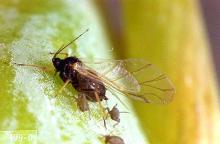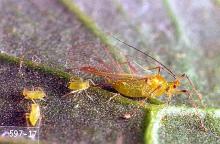Includes
Bean aphid (Aphis fabae)
Melon aphid (Aphis gossypii)
Potato aphid (Macrosiphum euphorbiae)
Pest description and crop damage The bean aphid is dark olive green to black with light-color legs. It is usually more of an early-year pest. The melon aphid is variable in color but is often light green mottled with dark green. Unlike other aphids, it is able to tolerate hot weather. The potato aphid has both a pink and green form. It is a larger aphid. High potato aphid populations can distort leaves and stems, stunt plants, and cause necrotic spots on leaves. These aphids also secrete a large amount of honeydew that promotes development of sooty mold on foliage and fruit.
Aphids damage plants by sucking plant sap, which causes heavily infested leaves to curl and stunts plants; excreting honeydew, which causes sticky, shiny leaves to turn black because of a sooty mold growth; and spreading plant diseases (a large number of viruses are spread by aphids). Infestations frequently are localized; heavily infested leaves curl down.
Management-cultural control
Aphid populations tend to be higher in plants that are fertilized liberally with nitrogen.
Home gardeners can use row covers or wash aphids from plants with a strong stream of water.
Management-chemical control: HOME USE
- acetamiprid
- azadirachtin (neem oil)-Some formulations are OMRI-listed for organic use.
- bifenthrin (often as a mix with zeta-cypermethrin).
- carbaryl
- cyfluthrin
- deltamethrin
- esfenvalerate
- imidacloprid
- horticultural oil-Some formulations are OMRI-listed for organic use.
- insecticidal soap-Some formulations are OMRI-listed for organic use.
- kaolin-When applied as a spray to foliage and stems, it acts as a repellent to some insect pests. Some formulations are OMRI-listed for organic use.
- malathion-Do not use on wet or damp foliage.
- permethrin
- plant-derived essential oils (rosemary, peppermint, thyme etc.)-Some formulations are OMRI-listed for organic use.
- pyrethrins-Some formulations are OMRI-listed for organic use.
- zeta-cypermethrin
Note: Pesticides can injure cucurbits. Be sure foliage is dry at time of application.
Management-chemical control: COMMERCIAL USE
- acetamiprid (Assail 30SG) 0.047 to 0.075 lb ai/A. PHI 0 days. REI 12 hr. Retreatment interval 5 days. Do not exceed 5 applications or 0.5 lb ai/A per season.
- alpha-cypermethrin (Fastac EC) at 0.02 to 0.025 lb ai/A. PHI 1 day. REI 12 hr. Retreatment interval 7 days. Do not exceed 0.075 lb ai/A per season.
- azadirachtin (Neemix 4.5)-PHI 0 days. REI 4 hr. See label for rates. Acts slowly; apply early. Thorough coverage and repeated applications are necessary.
- Beauveria bassiana (Mycotrol ESO) at 0.25 to 1 quart/A. PHI 0 days. REI 4 hr. OMRI-listed for organic use.
- bifenthrin (Brigade WSB) at 0.05 to 0.1 lb ai/A. PHI 3 days. REI 12 hr. Do not exceed 0.3 lb ai/A per season. Do not make more than two applications after bloom. Retreatment interval 7 days.
- bifenthrin/Avermectin (Athena) at 0.05 to 0.12 lb ai/A. PHI 7 days. REI 12 hr. Retreatment interval 7 days. Do not exceed 0.056 lb ai/A avermectin or 0.3 lb ai/A bifenthrin per season.
- bifenthrin/zeta-cypermethrin (Hero EW) at 0.04 to 0.1 lb ai/A. PHI 3 days. REI 12 hr. Retreatment interval 7 days. Do not exceed 0.4 lb ai/A per season.
- Chenopodium ambrosioides extract (Requiem 25EC) at 4 to 6 pints formulated product per acre. REI 4 hr. Use high rate when conditions are favorable for heavy pressure. OMRI-listed for organic use.
- chlorantraniliprole/thiamethoxam (Voliam Flexi) at 0.1 to 0.172 lb ai/A. PHI 1 day. REI 12 hr. Retreatment interval 5 days. Do not exceed 0.172 lb ai of thiamethoxam or 0.2 lb ai of chlorantraniliprole per acre per growing season.
- Chromobacterium subtsugae (Grandevo) at 0.6 to 0.9 lb ai/A per 100 gal. PHI 0 days. REI 4 hr. OMRI-listed for organic use.
- clothianidin (Belay) at 0.05 to 0.067 lb ai/A foliar; 0.15 to 0.2 lb ai/A soil. PHI 7 days foliar, 21 days soil. REI 12 hr. Retreatment interval 10 days. Do not exceed 0.2 lb ai/A per season.
- cyantraniliprole (Exirel) at 0.088 to 0.133 lb ai/A. PHI 1 day. REI 12 hr. Retreatment interval 5 days. Do not exceed 0.4 lb ai/A per year.
- dinotefuran (Scorpion 35SL) at 0.05 to 0.18 lb ai/A foliar or 0.23 to 0.27 lb ai/A soil. PHI 1 day (foliar), 21 days (soil). REI 12 hr. Do not exceed per season 0.266 lb ai/A foliar or 0.532 lb ai/A soil. Retreatment interval 7 days.
- flonicamid (Beleaf 50SG) at 0.062 to 0.089 lb ai/A. PHI 0 days. REI 12 hr. Do not exceed 0.267 lb ai/A or three applications per season. Retreatment interval 7 days.
- flupyradifurone (Sivanto 200SL) at 0.14 to 0.18 lb ai/A foliar; 0.27 to 0.37 lb ai/A soil. PHI 1 day foliar; 21 days soil. REI 4 hr. Retreatment interval 7 days. Do not exceed 0.365 lb ai/A per season.
- gamma-cyhalothrin (Declare) at 0.015 lb ai/A. PHI 1 day. REI 24 hr. Retreatment interval 5 days. Do not exceed 0.09 lb ai/A per season.
- imidacloprid (Admire Pro) at 0.25 to 0.38 lb ai/A soil or 0.016 lb ai/10,000 plants for planthouse. PHI 21 days. REI 12 hr. Do not exceed 0.38 lb ai/A per soil application. Do not exceed 0.0156 lb ai/10,000 plants. Limit 1 planthouse treatment.
- insecticidal soap (M-Pede) at 1 to 2% solution. Potassium salts of fatty acids. See label for gal/A rates. PHI 0 days. REI 12 hr.
- lambda-cyhalothrin/thiamethoxam (Endigo ZC) at 0.072 lb ai/A. PHI 1 day. REI 24 hr. Retreatment interval 5 days. Do not exceed 0.18 lb ai/A of lambda-cyhalothrin or 0.172 lb ai/A of thiamethoxam per season.
- malathion (Fyfanon 8) at 1 lb ai/A pumpkin and winter squash; 1.75 lb ai/A summer squash. PHI 1 day. REI 12 hr for pumpkin and winter squash and 24 hr for summer squash. Retreatment interval 7 days. Limit 2 treatments pumpkins and 3 treatments squash per year.
- oxamyl (Vydate L) at 0.5 to 1 lb ai/A foliar. PHI 1 day. REI 48 hr. Retreatment interval 7 days. Do not exceed 4 lb ai/A per season.
- permethrin (Permethrin) 0.2 lb ai/A. PHI 0 days. REI 12 hr. Retreatment interval 7 days. Do not exceed 1.2 lb ai/A per season.
- pymetrozine (Fulfill) at 0.086 lb ai/A. PHI 0 days. REI 12 hr. Retreatment interval 7 days. Two applications may be needed for persistent populations. Aphids stop feeding soon after treatment but may remain on plants 4 to 10 days, until they die. Do not exceed 0.172 lb ai/A per season.
- pyrifluquinazon (PQZ Insecticide) at 0.035 to 0.047 lb ai/A. PHI 1 day. REI 12 hr. Limit 4 treatments. Retreatment interval 7 days. Do not exceed 0.14 lb ai/A per year. Apply by ground equipment.
- tebuconazole/lambda cyhalothrin (Crossover) at 0.16 lb ai/A. PHI 7 days. REI 24 hr. Retreatment interval 10 days. Do not exceed 0.48 lb ai/A tebuconazole and 0.18 lb ai/A lambda cyhalothrin.
- thiamethoxam (Actara) at 0.023 to 0.047 lb ai/A. PHI 0 days. REI 12 hr. Retreatment interval 5 days. Do not exceed 0.172 lb ai/A per season.
- thiamethoxam (Platinum) at 0.078 to 0.172 lb ai/A soil. PHI 30 days. REI 12 hr. Do not exceed 0.172 lb ai/A per season. See label for recommended in-row application instructions.
- thiamethoxam/chlorantraniliprole (Durivo) at 0.196 to 0.257 lb ai/A applied to the soil. PHI 30 days. REI 12 hr. Do not exceed 0.172 lb ai of thiamethoxam or 0.2 lb ai of chlorantraniliprole per acre per growing season.
- tolfenpyrad (Torac) at 0.17 to 0.21 lb ai/A. PHI 1 day. REI 12 hr. Retreatment interval 14 days. Limit 4 treatments per year. Do not exceed 0.42 lb ai/A per year.
Note: Pesticides may injure cucurbits. The possibility of injury is less when foliage is dry at time of application.
These products contain commonly used active ingredients for control of aphid in pumpkin and squash. There are other materials available. Please consult a licensed crop advisor for additional recommendations.


